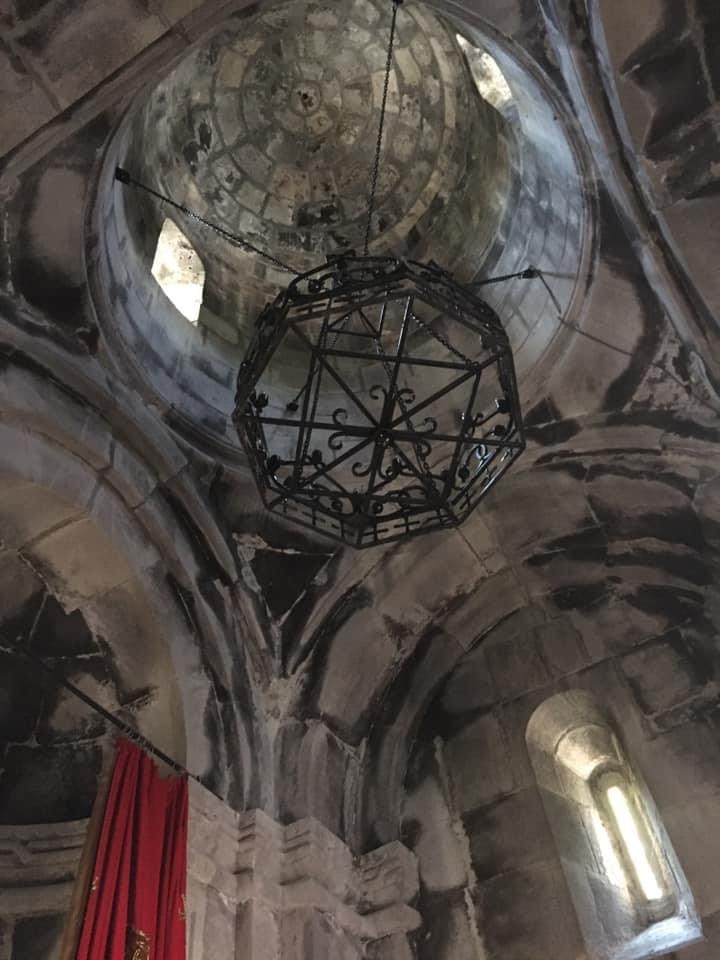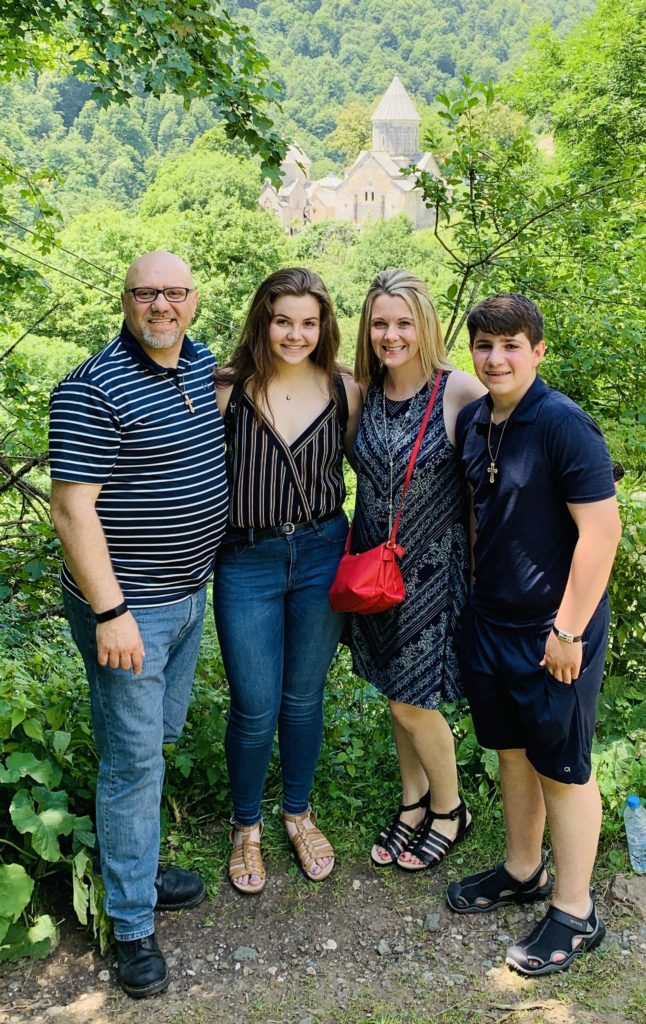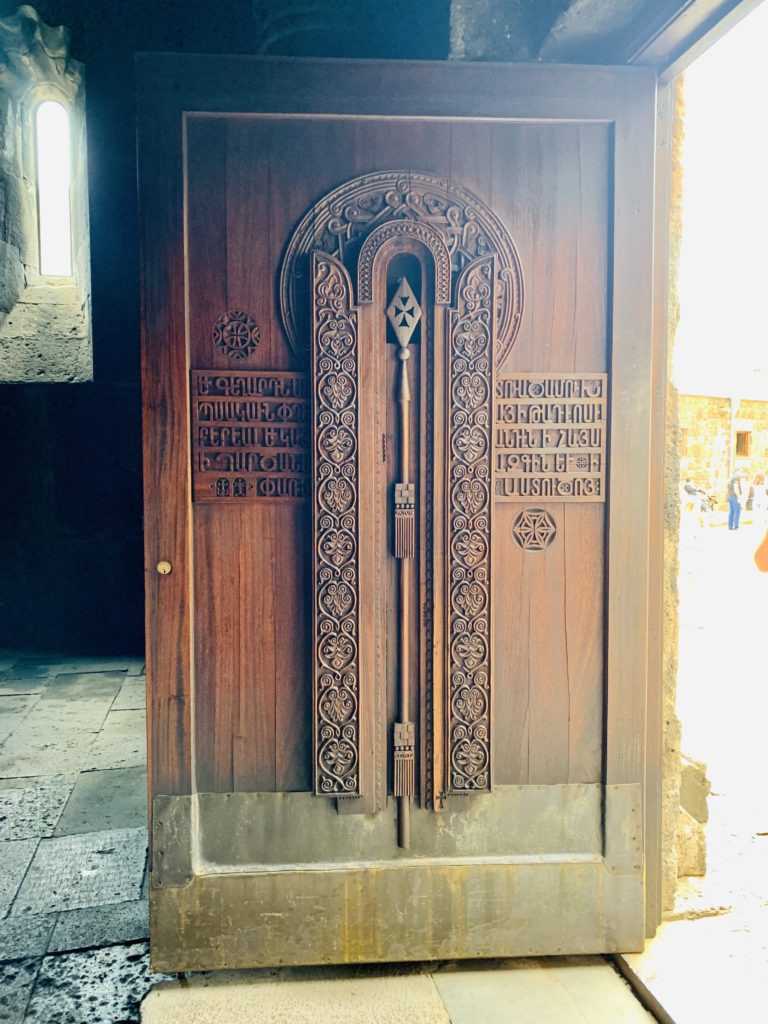
There is a place on my patio where the wind circles and lifts the freshly fallen colors of Fall, it’s beautiful and unpredictable, and a back drop to a difficult year. Difficult in all the collective ways of 2020, but also difficult in ways I’ve kept close to my heart. The world, in all its uncertainty continues to spin unpredictably, and we keep moving forward, spinning into each new season.
My Facebook memories continue to appear in spite of my tender heart, and as if our world hasn’t changed. Among these bittersweet memories were photos from our trip last summer to Armenia. As the colors of the season started to fall upon the ground, heartbreaking news came of unrest in Armenia.
It’s not lost on me that I hadn’t yet placed memories from our trip on this page. I can still recall the flowers in the fields, the warm sun on my face, and the crispness of what felt like living water from the well of an orchard field. The beauty in our experience had been overwhelming and the thought of trying to illustrate it into words seemed too daunting. Perhaps my stalling was for good reason. Reflecting now on the beauty of Armenia, hoping my words are enough, for such a time as this.

We had two long flights behind us, and we were headed to the crossroads of Europe and Asia. With our passports in hand, and in the dense midnight humidity of Qatar, we climbed the stairs to board our journey’s last flight. My husband has a way of tucking my heart inside of his. He is my high school sweetheart, and I would have followed him to the end of the earth. Little did I know that someday I practically would. After nearly thirty hours of travel, my husband and children had made it home.
This trip was a gift from my father-in-law. The Armenian Genocide which started in 1915 changed the course of his life and that of his children and grandchildren. This was a pilgrimage of sorts, a homecoming, and a testament to the tenacity of his people.
His grandfather was taken in shackles from his home never to return. His grandmother was forced to separate her young children, in hopes that they would survive. She would endure weeks of a death march through the Syrian desert with an infant in her arms. She found refuge in Aleppo, Syria, which would later be my husband’s birthplace. Her surviving children were raised in a Catholic orphanage as she had no means to care for them. She never returned to Armenia, and the sound of her husband’s shackles dragging along the cobblestone street would haunt her for the rest of her life. Her story was well told, tragically all of my husband’s great-grandparents faced similar fates.

We landed in the sleeping capitol city of Yerevan, and spent the ride to our hotel taking in the sights of arriving on the other side of the world. Yerevan is older than Rome. It has a beautiful eclectic blend of Soviet and European influences. The streets near our hotel were filled with quaint shops and sidewalk cafes. The architecture in Yerevan is ornate, and the city is rich in history, art and music. Signs of poverty are certainly there too, interlaced within the beauty.
We shared our pilgrimage with other families who are also part of the Armenian diaspora. Americans, Middle Easterners, a sweet couple from Portugal; they were lovely and warm and enriched our experience. Father Tadeos, an Armenian Priest serving the Eastern Diocese of the Armenian Church of America, graciously led our group. He was born and raised in Armenia, and now lives with his wife and children in Minnesota. He serves his St. Paul congregation, the only Armenian church in Minnesota.
The evening of our first day in Armenia, Father Tadeos welcomed us into his childhood village home. Young women dressed in traditional clothing stood just inside the home’s gate, and offered us bread and fruit as we entered. A customary sign of peace, breaking bread signifies peace amongst one another, and protection against mistrust.



We sat around a long table within the home’s courtyard. With an abundance of delicious food, fresh dishes with cilantro and dill, and kabobs cooked within a tonir (a deep round stone oven built into the ground), we learned more about one another. Stories of resilience were shared about where families found refuge following the genocide and where new lives for their children and grandchildren were built.
We spent nearly two weeks captivated by the beauty of Armenia, some moments of which will never leave my mind’s eye… our feet upon the stone floors of an early monastery, beautiful song filling the holy space, traditional dance in the city center, the terrace of a village restaurant nestled high upon a hill, local wine at the base of a waterfall, watching my children pick tart cherries from a tree, climbing the tall stone stairs of a 6,000 year old pagan temple, a beam of sunlight streaming through an ornate ceiling of a church creating a rainbow that fell at my daughters feet, rolling fields covered with purple wildflowers and bright orange poppies…





Tsitsernakaberd, the Armenian Genocide Memorial, is built on a hill overlooking Yerevan. The site was once an Iron Age fortress, and remnants of a castle remain. The memorial includes twelve stone slabs positioned in a circle, with an eternal flame at its center. There is an adjacent towering stone spire. The stones represent the twelve lost provinces of Armenia, and the flame is dedicated to the 1.5 million Armenians murdered during the genocide. The towering stone spire represents the national rebirth of Armenia.

April 17, 1927 Aleppo Syria
With the morning sun upon our faces and fresh flowers in hand, we walked towards the circular monument and descended the stairs. Facing the circle near the eternal flame were two elderly men upon their knees, their arms stretched towards the flame. The men called out and wept, and although not in English, their weeping needed no translation. My Father-In-law paced around the circle’s perimeter confessing to God that he couldn’t bring himself to forgive those who had murdered nineteen members of his family. Sometimes grief is angry.
My children placed flowers at the circle. The energy was transcending in this place, sacred energy that I am certain I have no words for. Perhaps it’s from the grief that people leave here. Maybe it rises from the eternal flame, from the souls of those who endured unimaginable suffering. Perhaps it comes from a powerful place of redemption, as generations return, changed, but thriving nonetheless. I ran my fingers across the cool stone as we climbed the stairs to leave.
Armenia has an indescribable way of pulling you in close… We spent an evening at an apricot orchard in a village outside of Yerevan. Father Tadeos’ childhood friend, Norayr, graciously opened his family’s orchard to us. The orchard had been in his family for generations. Norayr left his village to attend University, and lived and worked in Russia. He returned to run the orchard following his father’s death. The land there was picturesque, with Mount Ararat as a backdrop to the green lush fields. The home was simple and rustic.





We took our place at a long table set under the cover of apricot trees. The table was dressed in white lace and pretty mismatched serving pieces. We enjoyed homemade apricot wine and vodka alongside traditional village food. Norayr climbed a ladder and picked fruit directly from his trees placing apricots into our hands. He welcomed us back to Armenia, insinuating that Armenia was also our home. He shared an Armenian saying that translates, “Let your feet bring luck to this home”. We sang at the table, and danced on the simple stone terrace that separated their home from their gardens.
We walked out into the field where Norayr filled the orchard’s trough style well. Cold water rushed from somewhere within the soil’s core, filling the well. We placed our hands into what felt like living water. I can’t begin to understand the essence of this place, the pull it has on your soul. Again, perhaps it’s redemption as my children place their feet upon the soil.









It wasn’t all mystical. Jesus help me I’m not sure how we survived the taxi rides. New York cabbies have nothing on the Armenians. The ride may start out innocently enough, and just like that your driver turns into Jason Bourne. Even the pedestrians are fearless. Cars stop after people step directly into the road. It’s a hot mess. Armenia, I’m no fan of your spy movie high speed chase situation, and as long as I’m being honest, I don’t like your hamburgers either. But I’ve made peace with it, your delicious wine and world-famous brandy seem to be a fair enough trade off.
…and then, a ghapama dinner, followed by an image of humanity that is difficult to express. Ghapama is a traditional stuffed pumpkin dish prepared with rice, apricot, dried fruits, almonds, and dates. It’s often prepared for Christmas and special occasions. It alone might be worth the 30 hours of travel. We enjoyed our dinner in an eclectic bohemian loft restaurant with turquoise plates, boisterous laughter and large open windows. An Armenian girl, the daughter of the travel company’s owner, joined us for dinner that evening.
In the midst of the laughter we were invited to dance. I watched from a distance as this sweet girl with sparse eyebrows and lashes, her head covered with a knit hat, reached to take the hand of an Armenian American Oncologist. They danced with a brightly colored rug under their feet. The joining of their hands, paired with the joy on their faces brought me to a place of humanity that is difficult to express. The world had never felt smaller, nor more beautiful.

Armenia, you are tucked inside my heart, and from its place, on the world’s flip side, my humble prayer is this…
“In spite of the uncertainty that consumes us, may the world see you. May it see your rolling fields, and your majestic mountains, your battered churches and your tired masses, your living water and your faithful people, may the world see and know your history, may it recognize your unwavering resolve to hold fast to Christ even as doing so threatens your very existence. Lord, may you shield this small, gracious, resilient country. May you cover its beautiful people in your peace and strength. Lord, shield what remains of Armenia.”

I heard an amazing statement from a famous designer who long ago came up with the “wrap dress” and it has stood the test of time for decades upon decades. Her Mother and Father were both Holocaust survivors, but survivors of Auschwitz. Her statement made after all the comments of how generation after generation her family had been kicked out of each country they lived in, or forced out by means of tragedy up to the point of the Holocaust and how her mother was not supposed to be be able to ever even have a child. Yet she was born and she went on to raise a family and they raised families. She says when she looks back at the past not only is she her Mother’s and Father’s legacy; and the legacy of her Grandparents who died tragic deaths at the hands of evil men; but she was also her Mother’s vengeance. So too are your children, a legacy of all that continue to lay ahead, just like Paul was; but they are all their Grandparent’s vengeance; brought about by nothing less than love for one another. Love does vanquish any evil meant for harm. You are intricately tied and interwoven into a legacy that will span for generations and of a vengeance created out of the strength of a people who refused to give up on God, on faith, and on dreams of a better future. That’s an awesome legacy to be woven into.
(I hope this made as much sense outside of my head as it did inside my head.) Love you & miss you. Been thinking of you so much lately along with everyone else…